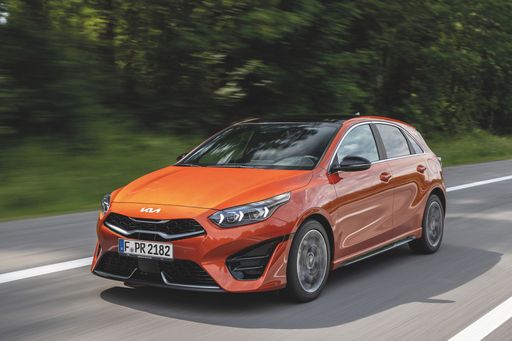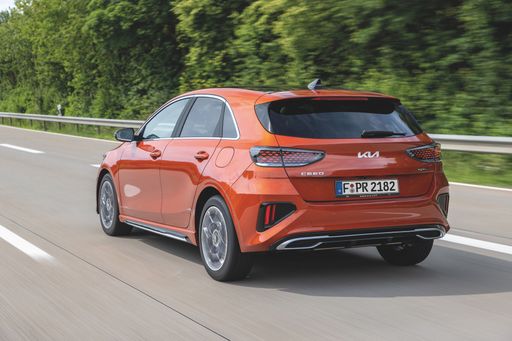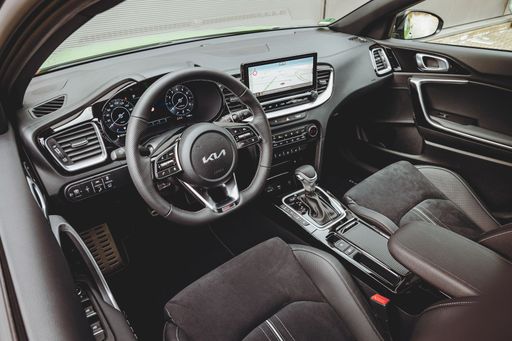Mitsubishi Colt VS Kia Ceed – Specs, Efficiency & Price Comparison
Which model is the better choice – the Mitsubishi Colt or the Kia Ceed? We compare performance (143 HP vs 140 HP), boot capacity (391 L vs 395 L), efficiency (4.20 L vs 6 L), and of course, the price (15400 £ vs 23100 £).
Find out now which car fits your needs better!
The Mitsubishi Colt (Hatchback) is powered by a Petrol or Full Hybrid engine and comes with a Manuel or Automatic transmission. In comparison, the Kia Ceed (Hatchback) features a Petrol MHEV or Petrol engine and a Automatic or Manuel gearbox.
When it comes to boot capacity, the Mitsubishi Colt offers 391 L, while the Kia Ceed provides 395 L – depending on what matters most to you. If you’re looking for more power, you’ll need to decide whether the 143 HP of the Mitsubishi Colt or the 140 HP of the Kia Ceed suits your needs better.
There are also differences in efficiency: 4.20 L vs 6 L. In terms of price, the Mitsubishi Colt starts at 15400 £, while the Kia Ceed is available from 23100 £.
Compare all the key specs now and find out which model fits your lifestyle best!
Mitsubishi Colt
The Mitsubishi Colt is a compact hatchback that combines practicality with a sleek design, making it an appealing choice for city drivers. Its efficient engine offers a balance of performance and fuel economy, which is ideal for everyday commuting. Inside, the Colt provides a comfortable cabin with intuitive controls and ample boot space for its class.
detailsKia Ceed
The Kia Ceed stands out in the compact car segment with its sleek design and impressive handling. It offers a comfortable and well-equipped interior that appeals to both drivers and passengers. With its efficient engine options, the Ceed provides a smooth and enjoyable driving experience suitable for city commutes and longer journeys alike.
details @ press.kia.com
@ press.kia.com
 @ press.kia.com
@ press.kia.com
 @ press.kia.com
@ press.kia.com

|
|
|
|
|
Costs and Consumption |
|
|---|---|
|
Price
15400 - 24800 £
|
Price
23100 - 31300 £
|
|
Consumption L/100km
4.2 - 5.4 L
|
Consumption L/100km
6 - 6.4 L
|
|
Consumption kWh/100km
-
|
Consumption kWh/100km
-
|
|
Electric Range
-
|
Electric Range
-
|
|
Battery Capacity
-
|
Battery Capacity
-
|
|
co2
96 - 121 g/km
|
co2
137 - 146 g/km
|
|
Fuel tank capacity
39 - 42 L
|
Fuel tank capacity
50 L
|
Dimensions and Body |
|
|---|---|
|
Body Type
Hatchback
|
Body Type
Hatchback
|
|
Seats
5
|
Seats
5
|
|
Doors
5
|
Doors
5
|
|
Curb weight
1131 - 1380 kg
|
Curb weight
1298 - 1390 kg
|
|
Trunk capacity
301 - 391 L
|
Trunk capacity
357 - 395 L
|
|
Length
4053 mm
|
Length
4315 - 4325 mm
|
|
Width
1798 mm
|
Width
1800 mm
|
|
Height
1439 mm
|
Height
1442 - 1447 mm
|
|
Payload
381 - 399 kg
|
Payload
470 - 500 kg
|
Engine and Performance |
|
|---|---|
|
Engine Type
Petrol, Full Hybrid
|
Engine Type
Petrol MHEV, Petrol
|
|
Transmission
Manuel, Automatic
|
Transmission
Automatic, Manuel
|
|
Transmission Detail
Schaltgetriebe, Automatikgetriebe
|
Transmission Detail
Automat. Schaltgetriebe (Doppelkupplung), Schaltgetriebe
|
|
Drive Type
Front-Wheel Drive
|
Drive Type
Front-Wheel Drive
|
|
Power HP
67 - 143 HP
|
Power HP
100 - 140 HP
|
|
Acceleration 0-100km/h
9.3 - 17.1 s
|
Acceleration 0-100km/h
9.5 - 13.2 s
|
|
Max Speed
160 - 174 km/h
|
Max Speed
178 - 197 km/h
|
|
Torque
95 - 160 Nm
|
Torque
172 - 253 Nm
|
|
Number of Cylinders
3 - 4
|
Number of Cylinders
3 - 4
|
|
Power kW
49 - 105 kW
|
Power kW
74 - 103 kW
|
|
Engine capacity
999 - 1598 cm3
|
Engine capacity
998 - 1482 cm3
|
General |
|
|---|---|
|
Model Year
2023 - 2024
|
Model Year
2024
|
|
CO2 Efficiency Class
D, C
|
CO2 Efficiency Class
E
|
|
Brand
Mitsubishi
|
Brand
Kia
|
Mitsubishi Colt
The Return of the Mitsubishi Colt: A Compact Driving Experience Reimagined
The Mitsubishi Colt makes a striking return to the compact car segment, blending advanced technology with a renewed design philosophy. Originally celebrated for its durability and practicality, the Colt's latest model showcases Mitsubishi's commitment to integrating modern innovation with their classic design ethos. In this article, we delve into the technical details and innovations that define the new Mitsubishi Colt.
Innovative Powertrains and Efficiencies
The new Colt offers a diverse range of powertrains, emphasizing both performance and efficiency. With options ranging from traditional petrol engines to advanced hybrid systems, drivers can choose a configuration that best suits their driving needs. The full-hybrid system stands out, offering a power output of up to 143 PS while maintaining an impressive fuel economy of as low as 4.2 L/100 km. This combination of efficiency and power positions the Colt as a formidable rival in its class.
For drivers prioritising efficiency without compromising on responsiveness, the turbocharged petrol engines deliver up to 160 Nm of torque, ensuring a dynamic driving experience. The manual and automatic transmission options further allow for customizable driving experiences, catering to both purists and those who prefer convenience.
Smart Design and Versatility
The Mitsubishi Colt's design is both functional and stylish, reflecting its hatchback body style. With dimensions of 4053 mm in length and 1798 mm in width, the Colt strikes a balance between a compact footprint and spacious interior. This design facilitates ease of manoeuvring in urban settings while providing adequate space for passengers and luggage, with a boot capacity ranging from 301 to 391 litres.
Inside, the Colt is designed with a driver-centric focus, providing a range of technological amenities and options for comfort. From the 'Basic' to the 'Top' trim lines, each variant includes a thoughtful selection of standard and optional features, ensuring that drivers can choose the specific configuration that fits their lifestyle and needs best.
A Focus on Safety and Environmental Responsibility
Safety is a priority with the Mitsubishi Colt, reflected in its abundant safety features and robust build quality. Equipped with modern driver assistance systems, the Colt is designed to minimize risks and offer peace of mind during travel. The model's commitment to safety does not overshadow its ecological considerations, as demonstrated by its CO2 emissions rating ranging from 96 to 121 g/km.
The Colt further addresses environmental concerns with its hybrid models, which not only reduce emissions but also enhance fuel efficiency. These features contribute to the vehicle’s respectable CO2 efficiency classes, ranging from C to D.
The Verdict: Compact Excellence
The 2023-2024 Mitsubishi Colt marks an exciting chapter in the evolution of compact cars, offering a blend of efficiency, performance, and practicality. With a starting price of 17,990 € and reaching up to 28,990 €, the Colt provides excellent value for money in its segment. Its balance of technology and traditional driving experience makes it a versatile choice for a wide range of drivers.
In summary, the Mitsubishi Colt defines itself as a competitive and innovative option for those seeking reliable, efficient, and technologically savvy automotive solutions. Whether commuting in the city or cruising on the open road, the Colt is engineered to deliver a satisfying driving experience with an eye towards the future of sustainable mobility.
Kia Ceed
Discovering the Kia Ceed: A Symbol of Modernity
In the dynamic world of automotive engineering, Kia has consistently stood out with its innovative and reliable models. The Kia Ceed is no exception, bringing a blend of efficiency, style, and cutting-edge technology to the table. Let's delve into the details of this eye-catching hatchback and uncover what makes it an alluring choice for modern drivers.
Power and Performance: Under the Hood
The Kia Ceed is equipped with an impressive range of powertrains, offering a selection between petrol engines and mild-hybrid technology. The engine lineup boasts power outputs from 100 to 140 PS, catering to both economical driving needs and those seeking a bit more thrill on the road. The engine choices are complemented by either a smooth manual transmission or a state-of-the-art dual-clutch automatic, ensuring an engaging driving experience tailored to individual preferences.
Efficient and Eco-Friendly Engineering
Kia's dedication to eco-friendliness is evident in the Ceed's engineering, offering remarkable fuel efficiency between 6 to 6.4 L/100km. This focus not only keeps running costs low but also helps reduce emissions, maintaining a responsible footprint with CO2 emissions ranging from 137 to 146 g/km. This efficient performance ensures the Kia Ceed is both a financially savvy and environmentally considerate choice.
Advanced Technologies and Safety Features
Innovation is at the heart of the Kia Ceed's design, with a suite of advanced technological features enhancing comfort and safety. The latest driver-assist systems help keep occupants secure, providing confidence on every journey. Lane Keeping Assist, Forward Collision Warning, and Intelligent Speed Limit Assist are just some of the high-tech features that work seamlessly in the background, making driving both safer and more relaxed.
Styling and Comfort: A Perfect Cabin Space
Stepping into the Kia Ceed, drivers and passengers are greeted by a sophisticated interior, designed for comfort and style. Seen in multiple variants including the Nightline Edition and GT Line, the Ceed offers a premium feel across all its models. With dimensions that promise ample space—stretching up to 4325 mm in length and offering a boot capacity between 357 to 395 L—the Ceed perfectly accommodates both daily commutes and adventurous getaways.
Value for Money: A Wise Investment
Balancing a competitive initial outlay, ranging from €25,590 to €35,090, with low running costs, the Kia Ceed redefines value for money. This hatchback's adaptability to various lifestyle needs, paired with monthly costs from €887 to €1,019, positions it as a wise investment in the current automotive market.
Conclusion: The Kia Ceed in a Nutshell
The 2024 Kia Ceed superbly combines power, efficiency, and cutting-edge innovations, making it a noteworthy contender in the hatchback segment. Whether it’s the eco-friendly credentials, advanced safety systems, or the blend of practicality and style, the Kia Ceed is primed to lead the way in the evolving era of modern vehicles.
The prices and data displayed are estimates based on German list prices and may vary by country. This information is not legally binding.
